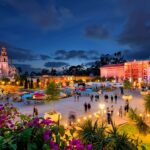Introduction
Nestled in the heart of the Sonoran Desert, the Desert Botanical Garden offers a unique glimpse into the vibrant life that thrives in arid environments. Spanning over 50 acres, this living museum is home to thousands of species of cacti, trees, and flowers from around the world, showcasing the beauty and diversity of desert plants. Beyond its role as a sanctuary for plant life, the garden serves as a hub for research, conservation, and education, making it a must-visit destination for nature lovers, conservationists, and anyone fascinated by the resilience of desert ecosystems.
The Desert Botanical Garden isn’t just a place to explore; it’s an experience that changes with the seasons, offering fresh perspectives and new wonders year-round. From the stunning bloom of cacti flowers in the spring to the enchanting glow of luminarias in the winter, the garden invites visitors to embark on a journey through the unique flora of the Sonoran Desert and its seasonal exhibits. Whether you’re a budget traveler looking for an affordable adventure, a luxury vacationer in search of a serene escape, or an adventure seeker eager to explore the great outdoors, the garden promises an unforgettable experience.
We’ll delve into the wonders of the Sonoran Desert, the highlights of the Desert Botanical Garden, and the can’t-miss seasonal exhibits that draw visitors from all corners of the globe. We’ll also share essential visitor information and tips to ensure your visit is as enriching and enjoyable as possible. So, lace up your walking shoes, and let’s embark on this journey together.
I’ll continue with the next section, focusing on the wonders of the Sonoran Desert, in the following response to keep the content organized and manageable. Let’s ensure this exploration captures the essence of the garden and its surroundings, appealing to your diverse audience.

The Wonders of the Sonoran Desert
Spanning vast stretches across the southwestern United States and northwestern Mexico, the Sonoran Desert is a land of extremes. It’s a place where temperatures can soar to scorching highs during the day and plummet to chilling lows at night. Despite these harsh conditions, the Sonoran Desert is alive with a rich tapestry of biodiversity, making it one of the most fascinating and diverse deserts in the world. Here, life has adapted in extraordinary ways, creating a vibrant ecosystem where every plant and animal plays a crucial role.
One of the desert’s most iconic residents is the saguaro cactus, standing tall as a symbol of the American West. These towering giants can live for over 200 years and grow to heights of 40 feet or more, providing habitat and nourishment for a myriad of desert creatures. The spring months bring a spectacular display as the saguaros and other cacti burst into bloom, dotting the landscape with splashes of color. This period draws pollinators, including bees, birds, and bats, setting off a chain reaction of life that echoes throughout the ecosystem.
But the saguaro is just the beginning. The Sonoran Desert is home to over 2,000 species of plants, each adapted in unique ways to thrive in this arid landscape. From the prickly pear cactus with its delicious fruits to the elusive desert marigold, the flora here is as diverse as it is resilient. Amidst the thorns and spines, there’s a surprising burst of color and life that challenges the stereotype of deserts as lifeless wastelands.
The fauna of the Sonoran Desert is equally impressive. The desert is a stage for the dramatic interplay of predators and prey, from the cunning coyote to the elusive desert bighorn sheep. Nighttime unveils a whole new world, as nocturnal creatures emerge to roam the cool desert landscape. The eerie call of the owl, the scuttle of the tarantula, and the slither of the rattlesnake add to the mystique of the desert after sundown.
The ecological significance of the Sonoran Desert extends beyond its borders, influencing climate, culture, and conservation efforts. It serves as a living laboratory where scientists and researchers can study the impacts of climate change on arid landscapes and their inhabitants. Moreover, the desert’s beauty and biodiversity inspire artists, writers, and photographers, sparking a cultural appreciation that transcends geographical boundaries.
As we explore the Desert Botanical Garden, we’ll see how this unique ecosystem is represented and preserved, offering visitors a microcosm of the Sonoran Desert’s wonders. The garden’s commitment to showcasing the desert’s flora and fauna provides an invaluable resource for education and conservation, inviting us all to appreciate the beauty and complexity of desert environments.

Exploring the Desert Botanical Garden
Nestled on the outskirts of Phoenix, Arizona, the Desert Botanical Garden stands as a testament to the beauty and diversity of desert flora. Founded in 1939 by a small group of local citizens passionate about conserving desert landscapes, the garden has since grown into a world-renowned living museum, educational hub, and research institution. With over 50,000 plants showcased across 140 acres, the garden offers an unparalleled opportunity to explore the vast array of adaptations and beauty found within desert ecosystems, particularly the Sonoran Desert.
A. History and Mission
The inception of the Desert Botanical Garden was driven by the vision to create a space dedicated to the study, conservation, and exhibition of desert plants. It aimed to educate the public about the importance of desert ecosystems and to promote conservation efforts for these often misunderstood landscapes. Over the decades, the garden has evolved, expanding its collections, enhancing its visitor experiences, and strengthening its research and conservation programs. Today, it stands as a leader in plant science, a protector of endangered species, and a sanctuary where visitors from around the globe can connect with nature in profound ways.
B. Garden Layout and Trails
The garden is meticulously designed to showcase the beauty and diversity of desert plants in an accessible and engaging manner. Five thematic trails wind through the garden, each offering a unique perspective on desert plant life:
- Desert Discovery Loop: Introduces visitors to the incredible variety of desert plants and their adaptations.
- Plants & People of the Sonoran Desert Loop: Explores the relationship between native plants and the cultures of the Sonoran Desert.
- Sonoran Desert Nature Loop: Offers stunning vistas and insights into the desert’s ecosystem.
- Center for Desert Living Trail: Demonstrates sustainable living practices in desert environments.
- Harriet K. Maxwell Desert Wildflower Loop: Showcases the vibrant wildflowers and pollinators of the desert landscape.
C. Major Exhibits and Collections
The Desert Botanical Garden is home to several significant exhibits and collections that highlight the astonishing diversity of desert environments:
- Cactus and Succulent Galleries: Home to one of the most comprehensive collections of cacti and succulents in the world, showcasing species from deserts around the globe.
- Agave Yucca Forest: Features a stunning array of agave and yucca species, illustrating their crucial role in desert ecosystems and human culture.
- Butterfly Pavilion: A seasonal exhibit that offers an up-close experience with native butterflies, emphasizing the importance of pollinators.
- Boojum Tree Forest: Displays the peculiar and rare Boojum trees, native to the Baja California peninsula, providing a glimpse into the unique flora of distant deserts.
Each area within the garden is designed not only to educate and inspire but also to provide a space for reflection and connection with the natural world. Whether you’re marveling at the towering saguaros, smelling the fragrant wildflowers, or watching butterflies flit from bloom to bloom, the garden offers endless opportunities to discover the wonders of the desert.
Visitor Information and Tips
Visiting the Desert Botanical Garden is an adventure that requires some planning to make the most of your experience. Here are a few tips:
- Best Times to Visit: Early morning or late afternoon offers cooler temperatures and softer light, ideal for photography and leisurely exploration.
- Maximizing Your Experience: Consider joining a guided tour to gain deeper insights into the desert’s secrets. Check the garden’s calendar for special events and exhibits that may coincide with your visit.
Seasonal Exhibits and Events at the Desert Botanical Garden
The Desert Botanical Garden isn’t just a static showcase of desert flora; it’s a dynamic entity that changes with the seasons, offering visitors new experiences and insights throughout the year. The garden’s seasonal exhibits and annual events are thoughtfully designed to highlight the diversity and beauty of desert plants, drawing visitors into the rhythms of nature that dictate life in the desert.
A. Spring: A Season of Bloom
Spring in the garden is a time of renewal and vibrant color, as many desert plants enter their blooming cycle. The garden becomes a painter’s palette of hues, with wildflowers, cacti, and succulents displaying their flowers in a spectacular show of life. The Spring Butterfly Exhibit is a highlight, where visitors can walk among native butterflies in a specially designed pavilion, witnessing the crucial role these pollinators play in the desert ecosystem.
B. Summer: Nighttime Wonders
As temperatures rise, the garden shifts its focus to the cooler, nocturnal side of the desert. The Flashlight Nights offer a unique opportunity to explore the garden after dark, using flashlights to discover nocturnal plants and animals. This event provides a rare glimpse into the activities of desert life under the cover of night, from blooming night-blooming cacti to the creatures that roam the landscape when the sun goes down.
C. Fall: Celebrating Harvest and Heritage
Fall at the garden is a time to celebrate the harvest and the rich cultural heritage of the Sonoran Desert. The Chiles & Chocolate Festival is a popular event, featuring local vendors offering gourmet chocolates, spicy salsas, and other delicacies made with ingredients native to the desert. It’s a sensory delight that combines the tastes, smells, and sounds of the desert in celebration.
D. Winter: Luminaria and Music
The winter season is marked by one of the garden’s most enchanting events, the Las Noches de las Luminarias. Thousands of hand-lit luminarias line the garden paths, creating a magical atmosphere that celebrates the spirit of the holiday season. Accompanied by live music performances, this event transforms the garden into a wonderland of light and sound, providing a peaceful retreat from the hustle and bustle of the holiday season.

Visitor Information and Tips for Seasonal Events
To make the most of these seasonal exhibits and events, here are some additional tips:
- Plan Ahead: Check the garden’s website for dates and ticket information for special exhibits and events, as some may require advance reservations.
- Dress Appropriately: Depending on the season, ensure you’re prepared for the weather—cool clothing and water in the summer, warm layers in the winter.
- Stay Informed: Follow the Desert Botanical Garden on social media or subscribe to their newsletter for updates on upcoming exhibits and events.
These seasonal transformations and special events not only highlight the beauty and diversity of the desert but also underscore the garden’s commitment to education, conservation, and the celebration of nature. Whether you’re a first-time visitor or a seasoned veteran, the Desert Botanical Garden offers endless opportunities to connect with the desert in profound and meaningful ways.
Visitor Information and Tips for the Desert Botanical Garden
Planning your visit to the Desert Botanical Garden is essential to ensure a memorable and enjoyable experience. Here are some practical tips and essential information to help you prepare for your adventure in this unique desert landscape.
Best Times to Visit
- Morning and Late Afternoon: To avoid the midday heat, especially during the warmer months, visit early in the morning or late in the afternoon. This is also when the light is most beautiful for photography.
- Seasonal Considerations: Each season offers a different experience. Spring is ideal for wildflower blooms, while cooler months are perfect for enjoying the garden’s events and nighttime exhibits.
Maximizing Your Experience
- Guided Tours: Take advantage of the guided tours offered by the garden. Knowledgeable guides provide fascinating insights into the plant species, garden history, and the ecology of the desert.
- Special Events and Exhibits: Check the garden’s calendar for special events and exhibits that might coincide with your visit. These can greatly enhance your experience.
What to Bring
- Water: Staying hydrated is crucial. Bring a water bottle, which you can refill at stations around the garden.
- Comfortable Footwear: Wear comfortable shoes suitable for walking on uneven paths.
- Sun Protection: Sunscreen, a hat, and sunglasses are essential to protect against the sun’s rays.
- Camera: Don’t forget your camera or smartphone to capture the stunning scenery and floral displays.
Facilities and Accessibility
- The garden offers amenities including a café, a garden shop, and restrooms.
- Most trails are wheelchair accessible, ensuring everyone can enjoy the beauty of the desert.
Beyond the Garden: Exploring the Area
After immersing yourself in the wonders of the Desert Botanical Garden, you might be inspired to explore more of what the surrounding area has to offer. Phoenix and its neighboring regions are rich in natural beauty, cultural heritage, and recreational activities.
- Hiking and Outdoor Activities: Take a hike up Camelback Mountain for panoramic views of the Phoenix area, or explore the many other trails within the Phoenix Mountain Preserve.
- Cultural Experiences: Visit the Heard Museum to learn about the art and history of Native American peoples, or explore the vibrant art scene in downtown Phoenix.
- Dining and Accommodation: From cozy cafes to luxurious resorts, the Phoenix area caters to all tastes and budgets. For accommodations, consider using Expedia, Hotels.com, or VRBO to find the perfect stay that fits your travel style, whether you’re a budget traveler or seeking luxury.

Why Visit the Desert Botanical Garden?
The Desert Botanical Garden is more than just a collection of plants; it’s a sanctuary that speaks to the soul, offering a profound connection to the natural world. It stands as a testament to the beauty, resilience, and diversity of desert life, inviting visitors to explore, learn, and be inspired. Whether you’re drawn to the garden for its beauty, its educational value, or the peace it offers, your visit supports important work in conservation, research, and the celebration of our planet’s incredible biodiversity.
In conclusion, a visit to the Desert Botanical Garden is an opportunity to immerse yourself in the unique flora of the Sonoran Desert, experience the garden’s seasonal exhibits, and perhaps, most importantly, see the world through a different lens. It’s a reminder of the delicate balance of life in the desert and the importance of preserving these precious ecosystems for future generations.






